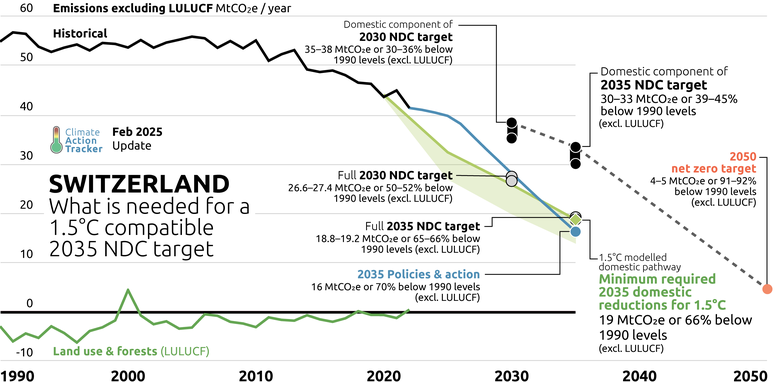2035 NDC
2035 NDC Target Overview

Switzerland’s 2035 NDC target of reducing GHG emissions by at least 65% compared to 1990 levels represents an absolute increase in ambition compared to its 2030 target of reducing GHG emissions by at least 50% compared to 1990 levels. However, a substantial gap remains between the target and the modelled domestic pathway (MDP). In fact, this gap has increased both in absolute and relative terms compared to the 2030 target, and the failure to narrow it in the latest update raises concerns about the level of ambition of the new target. A positive development is that the new NDC now outlines sectoral plans and interim targets covering buildings, transport, industry and other sectors, and commits to expanding renewable energy capacity in line with the global tripling renewables target.
A key concern remains: the lack of transparency regarding the share of emission reductions achieved domestically versus through international carbon credits. Without a clear breakdown of domestic reduction versus purchase of international credits, it is difficult to assess whether Switzerland’s efforts are in line with 1.5°C-compatible domestic pathways. The government has stated that the share of international reductions will decrease post-2030 – but it still hasn’t disclosed pre-2030 levels and has again failed to provide specific details on how it intends to cut emissions domestically, leaving uncertainties about actual ambition.
The CAT has therefore again had to make assumptions to quantify the 2035 target, applying the same assumptions we used for the 2030 target, specifically that 60 to 67% of the target will be realised domestically. The reliance on market mechanisms under the Paris Agreement's Article 6 without a specified reduction share limits transparency and could allow for loopholes that delay meaningful domestic action. Switzerland should provide a transparent and well-defined domestic emissions reduction target, ensuring that its commitments contribute meaningfully to global climate efforts.
Switzerland submitted its 2035 NDC mitigation target on 29 January 2025, setting a 2035 target of a reduction in its greenhouse gas emissions by at least 65% below 1990 levels. This target covers all gases and sectors except international aviation and maritime transport. The CAT excludes emissions or removals from land use, land use change and forestry (LULUCF) from this target, resulting in emission levels of 18.8 to 19.2 MtCO2e in 2035. However, as Switzerland continues to realise some of its emissions reductions abroad, again without specifying this share, it is not possible for the CAT to assess the target without making some assumptions. If 60 to 67% of the emissions reductions were realised domestically, it would lead to emissions levels of 30 to 33.5 MtCO2e in 2035.
The estimated domestic component of the newly submitted NDC of 30 to 33.5 MtCO2e in 2035 is not 1.5°C-compatible against modelled domestic pathways because it falls far short of the 1.5°C compatible threshold of 18.7 MtCO2e, excluding LULUCF. The CAT therefore rates this target as insufficient. If Switzerland scaled up its domestic action with the aim of realising the full target of 18.8-19.2 MtCO2e domestically, it would fall into the almost sufficient category, just on the edge of 1.5° compatible.
Switzerland's domestic 2035 NDC is set substantially higher than the current policy projection, meaning that without additional effort Switzerland is on track to meeting the target. This highlights the low level of ambition of the 2035 target.
Switzerland’s submitted 2035 NDC target did not increase the ambition of its 2030 mitigation target. A failure to substantially increase the ambition of Switzerland’s 2030 targets and action would mean limiting peak global warming to 1.5°C will be more difficult, and deeper and more rapid emissions reduction targets will be required elsewhere, which will likely lead to a multi-decadal, high overshoot of this limit, even if followed by strong 2035 targets.
| SWITZERLAND | 2035 NDC TARGET | |
|---|---|---|
| 2035 NDC target | ||
|---|---|---|
| Formulation of target in NDC |
To reduce its greenhouse gas emissions by at least 65 percent by 2035 compared to 1990 levels, to be implemented as an emission budget covering 2031–2035. 65% below 1990 levels by 2035 (incl. LULUCF) |
|
|
Absolute emissions level in 2035 excl. LULUCF |
Level of emissions to be achieved at home (domestic target component), assuming 60% to two-thirds (67%) of the target will be achieved domestically 30-33 MtCO2e [39-45% below 1990, excluding LULUCF] [39-45% below 2010, excluding LULUCF] Level of emissions to be achieved in total through domestic action and use of international market credits (full NDC target) 19 MtCO2e [65-66% below 1990, excluding LULUCF] [65-66% below 2010, excluding LULUCF] |
|
| Status | Submitted on 29 January 2025 | |
Ambition
For the world to have a significant chance of limiting warming to 1.5˚C, governments must switch to emergency mode and strengthen both their 2030 targets and current policies to include substantial emissions cuts and significantly contribute to closing the 2030 emission gap. Switzerland’s submitted 2035 NDC target did not increase the ambition of its 2030 target.
Switzerland’s 2035 NDC target is more ambitious than its 2030 target, aiming for a 65% reduction compared to a 50% reduction below1990 levels. The average annual emissions reduction is also higher – at 59% between 2031 and 2035, compared to 35% between 2021 and 2030. However, this increase follows a steady, linear path rather than a significant ramp-up of ambition, as it continues the same rate of reductions already required to meet the 2030 target. Therefore, a substantial gap remains between the new target and the modelled domestic pathway (MDP). This gap has even increased both in absolute and relative terms compared to the 2030 target, and the failure to narrow it in the latest update raises concerns about the level of ambition of the new target.
The NDC states that the share of emission reductions realised abroad will decrease for the 2031–2035 period compared to the pre-2030 period, so 2035 target’s ambition ultimately hinges on the level of this announced decrease. What is alarming with this statement is that the domestic reduction versus use of credit ratio for pre-2030 levels remains entirely unclear with just five years to go and this new NDC provides little clarity, leaving high uncertainties on the actual scale of domestic action.
2030 NDC Target
| 2030 unconditional NDC target (domestic) | 2030 conditional NDC target (full) | |
|---|---|---|
| Is the target 1.5°C compatible with modelled domestic pathways? |
|
️ |
| Is the target 1.5°C compatible with fair share? |
️ |
|
| Is this a stronger target? |
|
|
2035 NDC Target
| 2035 NDC target | ||
|---|---|---|
| Is the target 1.5°C compatible against modelled domestic pathways? |
|
|
| Does the NDC include sectoral targets? |
|
|
| Does the NDC include a renewable energy capacity target? |
|
|
| Does the target align with the country’s net-zero pathway? |
|
|
The estimated domestic component of the newly submitted NDC of 30–33.5 MtCO2e in 2035 is not 1.5°C compatible against modelled domestic pathways because it falls far short of the 1.5°C compatible threshold of 18.7 MtCO2e excluding LULUCF. The CAT therefore rates this target as insufficient. If Switzerland were to scale up its domestic action with the aim of realising the full target of 18.8-19.2 MtCO2e emission levels domestically, it would fall into the almost sufficient category, just on the edge of 1.5° compatible.
The 2035 NDC target includes sectoral plans and targets in buildings, transport, industry and other (agriculture, waste, F-gases) sectors. Its annex outlines Switzerland’s renewable generation targets.
Switzerland’s sectoral plans and targets align with the Global Stocktake (GST) and commitments such as tripling renewable energy capacity, phasing out inefficient fossil fuel subsidies, and ending deforestation by 2030.
The Federal Act on a Secure Electricity Supply from Renewable Energy Sources directly supports the GST renewable energy target, while the country also claims its transition away from fossil fuels and electrification of transport are in line with global net zero ambitions. Switzerland's biodiversity strategy and forest conservation laws also reinforce its commitment to halting deforestation, aligning with the Kunming-Montreal Global Biodiversity Framework.
Its participation in initiatives like the Global Methane Pledge and the Agreement on Climate Change, Trade, and Sustainability further reflects Switzerland's commitments to align with broader global climate goals. However, ongoing assessments will be crucial to ensure these sectoral measures contribute effectively to achieving international climate targets.
Further information on Switzerland’s net zero target can be found here.
Fairness & Finance
Developed countries need to significantly scale up international climate finance and other means of support. Developed countries should set 1.5°C aligned domestic mitigation targets in their NDCs and communicate the financial and other support they will provide to developing countries. Developing countries should clearly communicate the climate finance they need to set and achieve ambitious 1.5°C aligned conditional targets.
| 2035 NDC target | ||
|---|---|---|
| Does the target clearly communicate the climate finance contributions and other support to be provided and mobilised to other countries? |
|
|
Our methodology makes it clear that developed countries should set NDC targets that are at least compatible with their 1.5°C modelled domestic pathways and should meet these targets within their own borders and using their own resources. Switzerland’s submitted 2035 NDC is not 1.5°C compatible against modelled domestic pathways.
Developed countries are also expected to complement their ambitious domestic mitigation efforts with significant financial support for mitigation in other countries. Switzerland has communicated that it assesses its fair share of the USD 100bn to be between CHF 450–600m (~USD 290-650m) per year and intends to continue to mobilise that amount. However, with COP29 setting a new climate finance goal of USD 300bn annually by 2035, current levels of commitment fall short of the increased ambition now required. To align with the new global target and ensure adequate support for developing countries, Switzerland will need to scale up its climate finance contributions.
Credibility
Credible NDCs should build on robust national planning processes that translate the economy-wide emissions reduction target into action in all sectors. Governments need to ramp up the implementation of their existing targets and further develop policies to close the – still significant – emissions gap between current policies and 1.5°C. Contradictory policies must be addressed and reversed: fossil fuel production needs to be phased out, while fossil fuel exploration and fossil fuel subsidies need to stop.
| 2035 NDC target | ||
|---|---|---|
|
Is the target aligned with current policies AND driving more ambitious action? |
|
|
| Does the NDC reference national planning processes for its development? |
|
|
|
Does the NDC reference an institutional framework/plan in place for its implementation? |
|
|
|
Does the target commit to phase out fossil fuel production? |
|
|
| Does the target commit to stop fossil fuel exploration & subsidies? |
️ |
|
Switzerland is particularly vulnerable to the impacts of climate change, already experiencing a temperature increase of 2.8°C above pre-industrial levels, which underscores the urgency of its climate commitments.
The government claims to have successfully achieved prior targets, including its objectives under the Kyoto Protocol – although this assertion is only accurate when emissions reductions realised through offsets abroad are taken into account.
The second NDC was developed through a rigorous national planning process that incorporated public participation. It outlines a clear institutional framework for implementation, supported by the Climate and Innovation Act, which establishes intermediate targets and a long-term pathway toward achieving net-zero emissions. The NDC emphasises a focus on overall emissions reductions and sectoral strategies to address climate challenges. This context highlights Switzerland's proactive approach to balancing its climate commitments with the need for an effective energy policy.
However, Switzerland is one of the countries with a notable disparity between production-based and consumption-based emissions, meaning that while it may exhibit progress in reducing emissions attributed to domestic production, it effectively imports a considerable amount of emissions tied to the goods and services consumed by its population. Consequently, the decoupling of emissions from economic growth may appear valid in theory, but in practice it masks Switzerland’s reliance on imported emissions, which are not adequately accounted for in its climate strategy.
Transparency
Governments should set absolute, economy wide, emission reduction target trajectories including all GHG gases, specifying the emissions levels for each year as an absolute level of emissions (excluding LULUCF) so they are clear, transparent, and immune to creative accounting. NDC targets should primarily focus on their domestic reductions by decarbonising all sectors of the economy rather than relying on forestry sinks, other carbon dioxide removal (CDR) or international carbon markets.
| 2035 NDC target | ||
|---|---|---|
| Is the target based on fixed, absolute values? |
|
|
| Does the target cover all relevant sectors? |
|
|
| Does the target cover all greenhouse gases? |
|
|
| Does the target specify an emissions pathway? |
|
|
| Does the target separate out land use and forestry? |
|
|
| Does the target separate out other CO2 removal by type? |
|
|
| Does the target separate out the use of carbon credits? (Article 6) |
|
|
Switzerland's second NDC is based on fixed values for emission reductions compared to 1990 values. The target covers all sectors, including energy, agriculture, and waste, and includes all major greenhouse gases such as CO2, CH4, and N2O. The emissions pathway outlined features clear intermediate sectoral targets and legislative measures aimed at meeting them. However, the sectoral targets fall short of the overall reduction goal, cumulatively leaving a gap of over 10 MtCO₂ and bringing domestic reductions to less than 50%. This shortfall is likely to be covered by offsets under Article 6 rather than actual emission cuts. Furthermore, the target does not clearly separate the contributions from land use and forestry as well as other CO2 removal methods.
Switzerland's second NDC lacks transparency regarding the share of reductions that will come from carbon credits under Article 6, as it continues with vague statements like: “The share of emission reductions realised abroad will decrease for the 2031–2035 period compared to the pre-2030 period, consistent with the principle of progression. The percentage of domestic emission reductions will be determined in the context of parliamentary deliberations on the CO2 Law for the post-2030 period”.
The omission of a clear domestic component complicates accountability, as neither the CAT nor other stakeholders can assess how much of the target is achieved through international market mechanisms versus domestic actions. The unspecified role of credits furthermore creates uncertainty around the integrity of the emission reduction strategy. We have criticised this in the past – as this also applies to the 2030 target – and this new announcement does little to address those concerns. Ultimately, this ambiguity hinders Switzerland's ability to demonstrate effectiveness and transparency in meeting its climate obligations.
For more information, on Switzerland’s climate targets and policies, please click here.
For the CAT’s full recommendations for setting NDC targets that form the basis of the analysis above, please click here.
Further analysis
Latest publications
Stay informed
Subscribe to our newsletter




